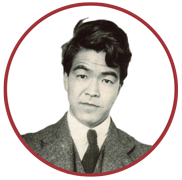One of the great joys of being Director of Villa I Tatti has been hosting visitors—from all over the world—who are still connected to Bernard Berenson. One such memorable occasion occurred when Yukio Yashiro’s daughter-in-law, Mrs. Wakaba Yashiro, and her daughter Toko Hirayama came to I Tatti in March 2013. We were fortunate enough to meet Mrs. Yashiro once more, and enjoy her charming hospitality, two months later when I was giving some lectures on Dante in Japan. On that occasion, Mrs. Yashiro gave me a folder with two splendid portraits of Yukio Yashiro, a brochure listing his many publications, and, intriguingly, the copy of a page from his book on Botticelli in which Yashiro most insightfully considers the influence of the Divine Comedy on the Florentine painter. Yashiro’s views on Botticelli’s drawings for the Divine Comedy are still very compelling. For him, these drawings “allow us the one opportunity of seeing [Botticelli’s] genius in its absolute purity,” even as, signaling his conversion “from a plastic painter into a religious mystic,” they poignantly represent “the beautiful suicide of Botticelli’s art.” Mrs. Yashiro did not speak about this to me, but the selection she made for me from her father-in-law’s book could hardly have been unintentional, for on the page she chose are the six lines from Purgatorio, in the famous English terza rima translation by Laurence Binyon, in which Dante describes the apparition of Beatrice in earthly paradise.
This quotation from Binyon’s translation is of some note, for it was Binyon who recommended Yashiro to Berenson when he came to Florence in the fall of 1921. In a letter dated 22 October of that year, now held in the Villa I Tatti’s archives, Binyon writes:
My dear Berenson,
I have taken the liberty of giving a letter to you to a young Japanese friend of mine called Yashiro who has just lately gone to Florence. I would not have done so if I hadn’t thought that you would like him & be interested to talk to him…..He has come to Europe to study European art, but hasn’t turned his back on his own. He cares about poetry, too, and in himself he seems to me really charming.
Laurence Binyon (1869-1943) was a poet, scholar, and expert orientalist, Keeper of the newly established department of Oriental Prints and Drawings at the British Museum. He knew Berenson well and corresponded with him from 1915 to 1939, often discussing Persian, Chinese, and Japanese literature and art. It was Binyon who raised the status of East Asian art in London’s literary circles in the 1910s. As an art historian and critic (he published a book on Botticelli in 1913), a Dante scholar and translator (his Inferno appeared in 1933, Purgatorio in 1938, and Paradiso in 1943), a poet, and a lover of Japanese literature and art, Binyon was, as it were, an English Yashiro, whose humanistic interests transcended all linguistic, geographic, and cultural differences. His introduction of the young Yashiro to Berenson was effectively a co-option based on the recognition that Yashiro was, in Berensonian terms, an unsereiner, “one of us.” Indeed, as if to underline this fact, in the folder that she gave me, Mrs. Yashiro included a sheet of paper with two moving poems that Binyon wrote when he visited Japan in 1929: “Momiji”, on the Japanese maple tree, “burning” in the fall, and “Miyajima”, on the homonymous small island near Hiroshima. With their dazzling and melancholy pictures of a fleeting paradise on earth, both poems remind one of that other green haven of beauty and quiet contemplation, which is, on our side of the world, Villa I Tatti. Binyon was spell-bound by the beauty of the Japanese landscape just as much as Yashiro was by the Italian, and the love of beauty – the beauty of nature, of art, of poetry, of human intelligence and goodness – united them beyond all their differences. That is why Binyon introduced Yashiro to Berenson.
I have always been intrigued by the mysterious ways in which individuals of the most distant and different origins, languages, and backgrounds, come to meet and interact, sometimes in such profound and lasting ways that it can be hard in retrospect to accept that their coming together happened by chance. The relationship between Bernard Berenson and Yukio Yashiro, brought about by the inspired mediation of their common friend Laurence Binyon, is one of these extraordinary stories.
I am delighted that this story is now being told in the very words of Berenson’s and Yashiro’s letters, and I am extremely grateful to all those who, from within and without Villa I Tatti, have contributed with their passion and hard work to make it accessible to everyone. My warmest thanks go to Mrs. Wakaba Yashiro for showing us some of the places where her father-in-law lived and some of the remarkable work that he started and inspired in Japan. Without her quiet enthusiasm, and her gracious encouragement and participation, this exhibition would not have seen the light.
Lino Pertile
Director of Villa I Tatti, 2010-2015

